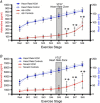Catecholamine response to exercise in patients with non-obstructive hypertrophic cardiomyopathy
- PMID: 30552684
- PMCID: PMC6395414
- DOI: 10.1113/JP277494
Catecholamine response to exercise in patients with non-obstructive hypertrophic cardiomyopathy
Abstract
Key points: Intense physical activity, a potent stimulus for sympathetic nervous system activation, is thought to increase the risk of malignant ventricular arrhythmias among patients with hypertrophic cardiomyopathy (HCM). As a result, the majority of patients with HCM deliberately reduce their habitual physical activity after diagnosis and this lifestyle change puts them at risk for sequelae of a sedentary lifestyle: weight gain, hypertension, hyperlipidaemia, insulin resistance, coronary artery disease, and increased morbidity and mortality. We show that plasma catecholamine levels remain stably low at exercise intensities below the ventilatory threshold, a parameter that can be defined during cardiopulmonary exercise testing, but rise rapidly at higher intensities of exercise. These findings suggest that cardiopulmonary exercise testing may be a useful tool to provide an individualized moderate-intensity exercise prescription for patients with HCM.
Abstract: Intense physical activity, a potent stimulus for sympathetic nervous system activation, is thought to increase the risk of malignant ventricular arrhythmias among patients with hypertrophic cardiomyopathy (HCM). However, the impact of exercise intensity on plasma catecholamine levels among HCM patients has not been rigorously defined. We conducted a prospective observational case-control study of men with non-obstructive HCM and age-matched controls. Laboratory-based cardiopulmonary exercise testing coupled with serial phlebotomy was used to define the relationship between exercise intensity and plasma catecholamine levels. Compared to controls (C, n = 5), HCM participants (H, n = 9) demonstrated higher left ventricular mass index (115 ± 20 vs. 90 ± 16 g/m2 , P = 0.03) and maximal left ventricular wall thickness (16 ± 1 vs. 8 ± 1 mm, P < 0.001) but similar body mass index, resting heart rate, peak oxygen consumption (H = 40 ± 13 vs. C = 42 ± 7 ml/kg/min, P = 0.81) and heart rate at the ventilatory threshold (H = 78 ± 6 vs. C = 78 ± 4% peak heart rate, P = 0.92). During incremental effort exercise in both groups, concentrations of adrenaline and noradrenaline were unchanged through low- and moderate-exercise intensity until reaching a catecholamine threshold (H = 82 ± 4 vs. C = 85 ± 3% peak heart rate, P = 0.86) after which levels of both molecules rose rapidly. In patients with mild non-obstructive HCM, plasma catecholamine levels remain stably low at exercise intensities below the ventilatory threshold but rise rapidly at higher intensities of exercise. Routine cardiopulmonary exercise testing may be a useful tool to provide an individualized moderate-intensity exercise prescription for patients with HCM.
Keywords: cardiopulmonary exercise testing (CPET); catecholamines; exercise physiology; exercise prescription; hypertrophic cardiomyopathy.
© 2018 The Authors. The Journal of Physiology © 2018 The Physiological Society.
Figures


Comment in
-
Could genetic and epigenetic factors explain hypoxia tolerance and superior muscle performance of Sherpas at high-altitude?J Physiol. 2019 Mar;597(5):1231-1232. doi: 10.1113/JP277593. Epub 2019 Jan 28. J Physiol. 2019. PMID: 30632151 Free PMC article. No abstract available.
-
Hypertrophic cardiomyopathy and exercise: a need for more information.J Physiol. 2019 Mar;597(5):1225-1226. doi: 10.1113/JP277538. Epub 2019 Feb 3. J Physiol. 2019. PMID: 30673131 Free PMC article. No abstract available.
-
Exercising caution: is there a role for exercise testing in the hypertrophic cardiomyopathy population?J Physiol. 2019 Apr;597(7):1789-1790. doi: 10.1113/JP277778. Epub 2019 Mar 10. J Physiol. 2019. PMID: 30807651 Free PMC article. No abstract available.
-
Big heart, no longer a big problem: using catecholamine-based quantifications may be an effective means to prescribe exercise to non-obstructive hypertrophic cardiomyopathy patients.J Physiol. 2019 May;597(9):2329-2330. doi: 10.1113/JP277970. Epub 2019 Apr 3. J Physiol. 2019. PMID: 30891752 Free PMC article. No abstract available.
References
-
- Baggish AL, Ackerman MJ & Lampert R (2017). Competitive sport participation among athletes with heart disease: A call for a paradigm shift in decision making. Circulation 136, 1569–1571. - PubMed
-
- Baggish AL, Yared K, Wang F, Weiner RB, Hutter AM, Jr. , Picard MH & Wood MJ (2008). The impact of endurance exercise training on left ventricular systolic mechanics. Am J Physiol Heart Circ Physiol 295, H1109–H1116. - PubMed
-
- Beaver WL, Wasserman K & Whipp BJ (1985). Improved detection of lactate threshold during exercise using a log–log transformation. J Appl Physiol (1985) 59, 1936–1940. - PubMed
-
- Billman GE (2002). Aerobic exercise conditioning: a nonpharmacological antiarrhythmic intervention. J Appl Physiol (1985) 92, 446–454. - PubMed
-
- Carroll JF, Convertino VA, Wood CE, Graves JE, Lowenthal DT & Pollock ML (1995). Effect of training on blood volume and plasma hormone concentrations in the elderly. Med Sci Sports Exerc 27, 79–84. - PubMed
Publication types
MeSH terms
Substances
LinkOut - more resources
Full Text Sources
Research Materials

